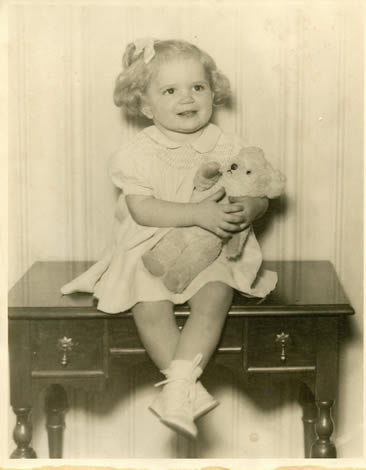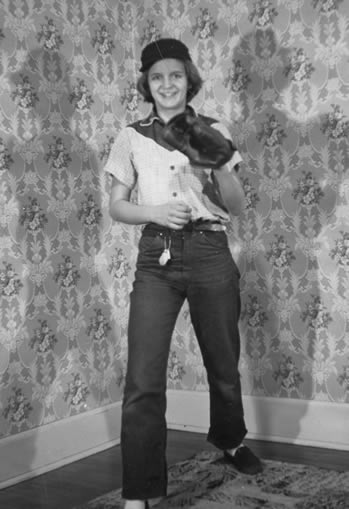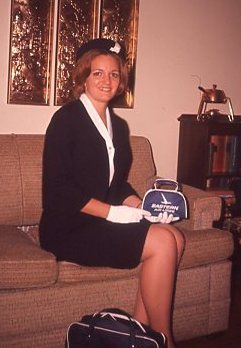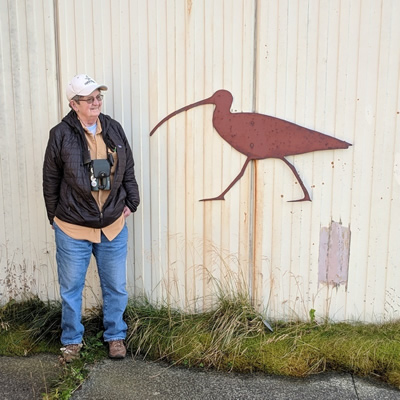Barbara McClure Haas
June 12, 1939 - January 8, 2020
by Franklin Haas
Note: This essay is about Barb, but so many of the things she did were done with me. However, she was often the driving force behind many of these things – not a dutiful wife following her husband’s lead. We were a co-equal team.
****************************************************************************************************************************
She was born Barbara McClure (no middle name) on June 12, 1939 in Philadelphia to Raymond McClure and Rose Floyd McClure.
She was an only child.

When she was in kindergarten, the elementary school prinicipal sent a letter to her parents about possibly skipping a grade and going directly into second grade from kindergarten.
Here is a portion of that letter...
"We believe it is wise that Barbara be promoted into second grade for these reasons: Barbara reads very well and is so far in advance in this subject that it isn't possible to keep her profitably busy [I love that phrase!] in grade 1: she is large for her age and seems mature enough to be associated with children in grade 2.
On the other hand, we have hesitated because of certain personal traits which we do not feel should be accentuated.
Barbara has a pretty good opinion of herself [REALLY?], which if it is emphasized, we feel will make her unpopular with the children with whom she is associated. We do not want this change into another grade to affect her this way. She is too sweet and pleasant a little girl for this to happen."
Yeah, we don't want those sweet and pleasant girls to get too uppity!
That was a different time...
When we attended her 50th High School reunion in 2006, one of the photos they had on display was their first grade class.
She wasn't in it...

She graduated Sharon Hill High School in 1956.
In 1957, she had a waterskiing accident that crushed several disks in her back. Over the next ten years, she underwent five surgeries – the first one to fix the disks, the other four to remove scar tissue that kept building up at the surgical site.
It was during her recuperation from one of these surgeries that friends of her family put up a bird feeder outside her bedroom window and gave her a field guide (Robbins) and binoculars. She studied the field guide (and the few birds that came to the feeder) and read other bird books (most notably the National Geographic Society two-volume set – Water, Prey, and Game Birds of North America and Song and Garden Birds of North America). She made copious notes in the margins of her field guide. After recovery, those same friends took her out on a couple of birding field trips to nearby spots. This was her extant of birding – she didn’t really pursue it. So she was book-smart about birds, but had no field experience to speak of.
She graduated from Ursinus College in 1960, then traveled to Europe from September 1962 to December 1964, living and working in Luxembourg, Switzerland, Germany, and Austria (she worked at the Innsbruck Winter Olympics in January - February 1964). Unfortunately she was not birding at that time...
After working other jobs (Eastern Airlines and Wyeth Laboratories), she returned to college and got a Masters Degree in Audiology from Kent State University in 1971. She was at Kent State during the student massacre and knew one of the students who got killed.

After getting her degree, she accepted a job at Geisinger Medical Center in Danville and moved into half of a duplex in Riverside (just across the river from Danville).
The other half of that duplex was occupied by me.
We met and, after a couple of weeks, she asked me where I disappeared to every weekend. I told her Hawk Mountain to watch hawks. She said "I’m interested in birds..."
I asked her if she would like to come along the following weekend, and – amazingly – she said yes!
That was our first date.
On the drive down to the mountain, I discovered that she was intelligent, knowledgeable (there's a difference!), her sense of humor matched mine, as did her politics (we were both fiscal conservatives and social liberals at the time).
What more could I ask for?
When we got to the North Lookout (early November) the wind was blowing strongly out of the northwest – an ideal migration day. Not being an outdoorsy person, her wardrobe was not up to the cold conditions we experienced that day. (The following week, we went shopping together to get her some real clothes!)
However, a hawk-watching friend of mine, Doug Cook, just happened to have an extra down-filled jacket in his backpack and graciously lent it to her. And – to top it off – he lit up his little burner and brewed some hot tea for her – spiked with something a little extra.
We had 5 eagles that day – 4 Bald and one Golden – plus a bunch of Red-tails, etc., and she was hooked. She quickly got to love the birding community. First hawkwatchers and then the wider group of birders. And the feeling was mutual from them.
She was hooked (and I on her) and we started going out birding together every chance we got. Not just locally, but up and down the east coast and a memorable trip to northern California in November 1972 (her first western trip).
That was our first major birding trip together.
In November 1972, she was slated to go to an audiologists’ convention in San Francisco. At the last minute, her boss – Frank Derossi – couldn't go and offered his plane ticket to Barb who asked me if I wanted to go with her.
I did!
So I got on the plane as Frank Derossi – this was long before the TSA!
We got to San Francisco, rented a Ford Pinto for $99 for a week, went to the convention hotel, she registered for the conference, and then we went birding for five days!
Two memorable moments from that trip.
We were south of Sacramento, driving down the coast after dark, looking for a place to spend the night. We got to some small town, but didn't see any motels. We spotted a patrol car and asked the cop if there were any motels nearby. He gave us directions and we quickly found the place.
It was a series of little cabins or bungalows. The proprietor, a young lanky man, checked us in and directed us to our cabin.
After getting our stuff inside, I turned to Barb and said "Doesn't he remind you of Anthony Perkins?"
She immediately shoved a chair up under the door knob and didn't take a shower that night!
True story.
For those of you who might not get the reference, watch the movie Psycho.
Earlier in the trip, we were down on a rocky beach. She had gone ahead of me around an outcropping and I heard her yell to me "What bird is all black with a large bright orange bill?"
I yelled back – in my best know-it-all voice – "There ain't no such bird!"
I then rounded the outcropping to see a Black Oystercatcher which is all black with a large bright orange bill.
She never let me forget that!
She rapidly became as avid a birder as I was.

After attending the founding conference of the Hawk Migration Association of North America in 1974, we purchased 20 acres on Little Mountain (Northumberland County) and built a 35-foot tall hawkwatching tower to record the hawk migration there. We manned that location for 15 years. It never was a prime location, but it was fun.
We married in November 1974 and moved to Ridley Creek State Park in Delaware County, where I was the new Park Manager. Barb accepted an audiologist position job at the Elwyn Institute.
Having been regulars (and official counters) at Hawk Mountain for years, we were missed when we started hawkwatching at Little Mountain. One weekend, our freinds at HMS concocted a scheme to send us letters applying for membership in the Ha-Ba Hawkwatching Association, including twenty-five cents annual dues! We received around thirty of them (including one from James Bond -- no, not the spy, but the ornithologist who lived next door to Ian Fleming and whose name was used for the fictional character!).
In 1975, Barb suggested that we hold a picnic for them as a thank-you for their friendship and to keep in touch. We also invited other birders that we knew. This became an annual event and the invitee list grew as we met new birders from near and far. The attendance approached 100 with birders coming from as far away as Texas. We hosted that picnic until 1989 when we moved to Narvon and no longer had the room for such a gathering.
In November 1982, the Delaware Valley Ornithological Club (DVOC) voted to permit women to join their organization. We had not joined because of the male-only rule. However, once the rule was changed, we both joined in 1983 and became very active members.
In 1984, a fellow DVOCer, Ed Fingerhood, suggested to us (knowing our interest in all things Pennsylvania ornithological) that Pennsylvania should do a Breeding Bird Atlas (BBA). We subsequently met with Frank Gill of the Philadelphia Academy of Natural Sciences and the Pennsylvania BBA was begun.
In 1985 we decided to do a Big Year in Pennsylvania in 1986. We decided to do it on the model that Jim Vardaman had used in 1979 to do a North American Big Year (see Call Collect, ask for BIRDMAN, St. Martin’s Press, 1980). He sent out a monthly newsletter to birders all around the country keeping them apprised of what he had seen so far and encouraging them to call if they found something he hadn’t yet seen.
So we started sending out a one-page newsletter to birders all across the state. We ended up with 288 species, which was a record at the time. This was all pre-internet!
But, more importantly, we established a mailing list of Pennsylvania birders and discovered how easy it was to create a publication (albeit just one page) on a computer. Barb suggested that we create a state-wide birding publication. We contacted the birders on the list and asked if they would subscribe to such a thing. The overwhelming response was positive, so Pennsylvania Birds was born. The first issue was mailed in June 1987. The Pennsylvania Society for Ornithology (PSO) was formed in 1989 and adopted Pennsylvania Birds as their official journal. We edited and published it until 2000 and then turned it over to the PSO.
In 1987, Barb was elected Treasurer of the DVOC (the first female to hold that position) and continued until 1996. We were awarded the Witmer Stone Award from the DVOC in 1988, elected a Fellows of the DVOC in 1989, and awarded the DEVOC in 1996.
In April,1989 she was a founding member and Secretary of the Pennsylvania Ornithological Records Committee and served several years.
In October 1989 I accepted the position of Computer Guru (not the official title!) for the Bureau of State Parks in Harrisburg. We moved to Narvon from where I commuted to Harrisburg and Barb commuted back to Delaware County. Barb quickly tired of that and instead opened her own hearing aid business.
She was often approached by fellow birders asking about help with hearing loss. The most common hearing loss is high frequencies – critical for birding. At an audiologists’ convention, she was introduced to a new piece of hearing aid technology called the K-Amp. Unlike most hearing aids, this receiver emphasized higher frequencies. Most hearing aids are aimed at speech recognition – the moderate frequencies.
So, she got one of the hearing aid manufacturers that she worked with to create a custom hearing aid using that technology. She called it The Birder. She sold this to many birders all across the country until they stopped making the K-amp and switched to digital technology in the mid-2010s.
In 1991, we co-edited the second edition of A Guide to the Birds of Lancaster County, Pennsylvania (Lancaster County Bird Club, 1991). And in 2005, co-edited the second edition of Annotated List of the Birds of Pennsylvania (Pennsylvania Biological Survey, Ornithological Technical Committee, 2005).
When a Hoary Redpoll visited our feeders in March 1994 and birders flocked to our house to see it, Barb suggested putting out a box for donations for bird conservation. We raised over $300 which we donated to the Nature Conservancy. Likewise, when the Black-backed Oriole showed up in 2017 (about 20 minutes from where we live), Barb suggested to the homeowners, Tom and Linda Binder, that they also put out a donation box. They raised over $1500 which was also donated to conservation organizations.
We were awarded the Earl Poole Award from the PSO in 2001.
We conducted numerous Breeding Bird Surveys, Christmas Bird Counts, Migration Counts, Big Days, Big Years, Roundups, and BBA blocks over the years.
We traveled extensively around the country and Barb had an ABA lifelist of 724 and a Pennsylvania list of 393.
Since 2005, we have traveled annually to Adak, Alaska, adding many new records for the island, including the first North American record of Eurasian Sparrowhawk.

She was very gregarious and could strike up a conversation with anyone. In addition to birding, she loved playing golf, following the Phillies and Eagles, and doing the New York Times crossword puzzle.
She was diagnosed with late-stage ovarian cancer in early November and died two months later.
The Pennsylvania birding community owes much to her efforts.
She will be missed.